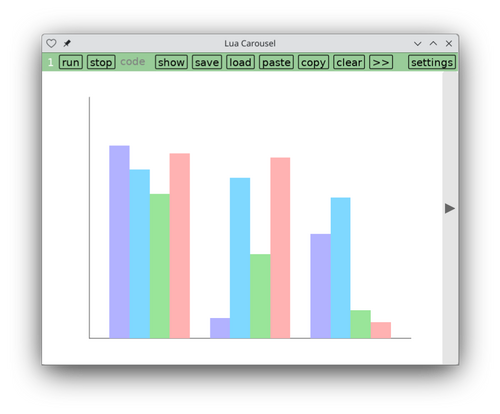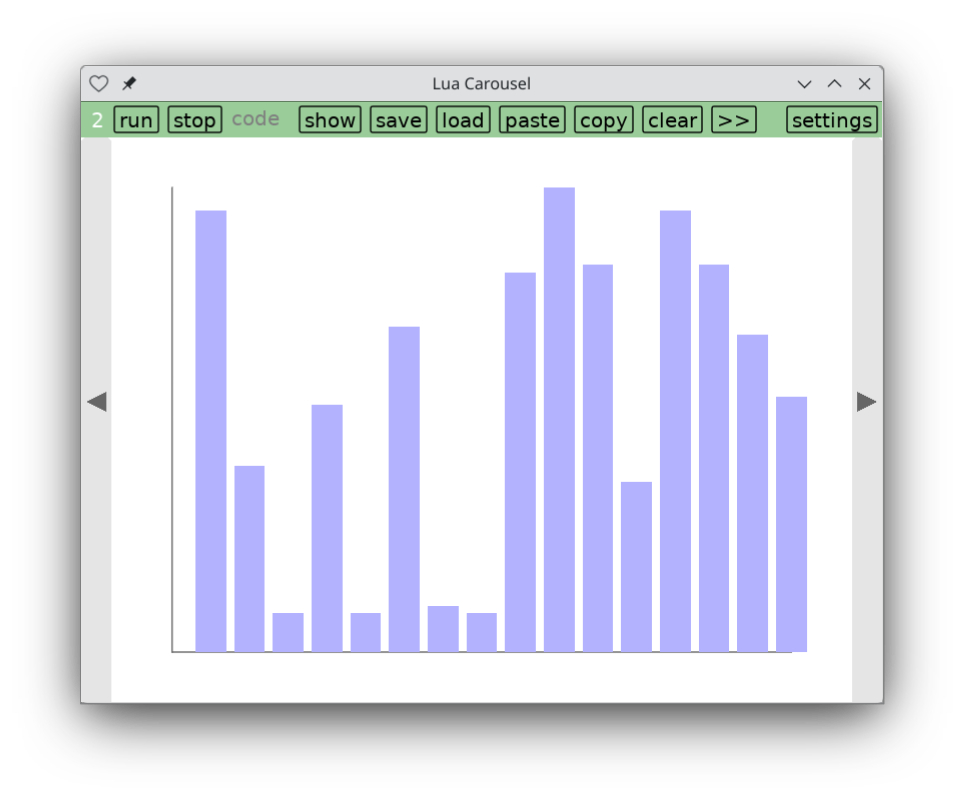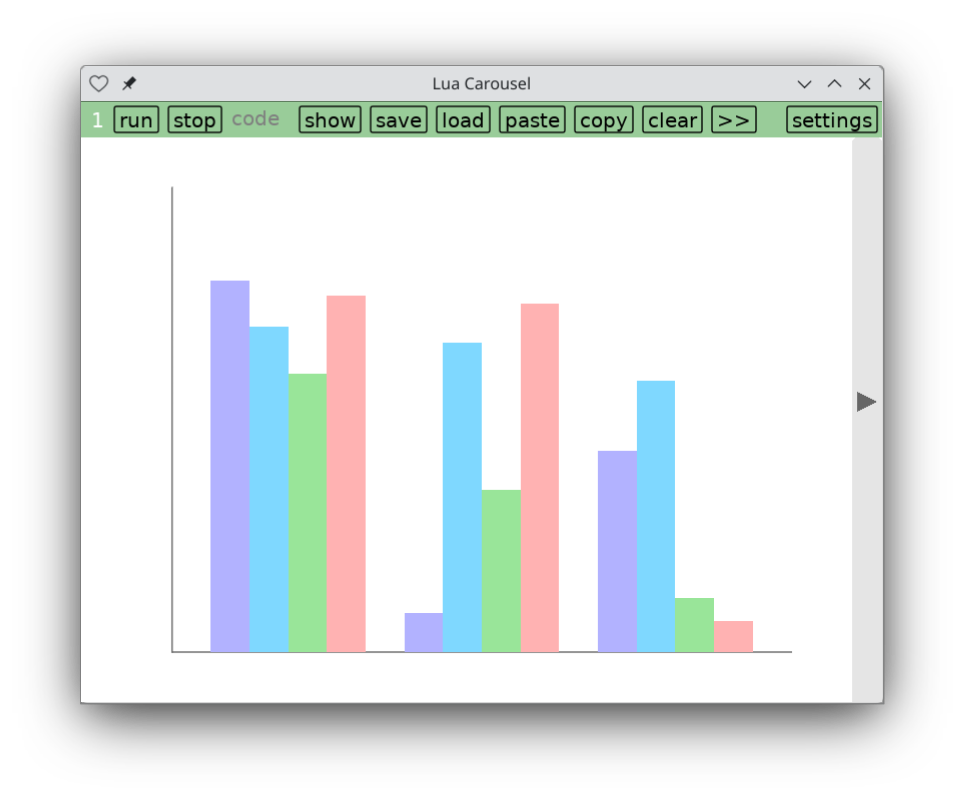Drawing histograms

When I last showed how one might draw lots of different kinds of charts in Lua Carousel, I mentioned that histograms were still an open question. I think I have a reasonable way now to work in support for them.
A suitable point of take-off is the `boxes` chart I showed earlier.
function boxes(data, i, x, y, w)
local w = optional(w, data, i, 5)
local y = y(data, i)
rect('fill', vx(x(data, i)-w/2), vy(y), scale(w), vy(0) - vy(y))
end
You call it like this:
color(0.7,0.7,1) plot(data, boxes, col(1), col(2), 4)
on some test data like this:
data = {}
for i=1,16 do
table.insert(data, {i*5, rand(60), rand(60)})
end
And you get a picture like this:
 (I'm glossing over 40 lines of code, but they're almost identical to my previous post. You can see them at the bottom.)
(I'm glossing over 40 lines of code, but they're almost identical to my previous post. You can see them at the bottom.)
A histogram is similar, but shows bars in clusters. Here's a new chart type:
function hbox(data, i, cluster, ncluster, y, w)
local w = optional(w, data, i, 5)
local clusterw = ncluster*w
local x = (i-1)*clusterw + cluster*w
local y = y(data, i)
rect('fill', vx(x), vy(y), scale(w), vy(0) - vy(y))
end
This draws just one bar in each cluster, but it lets you string clusters together. For example, consider some example data containing 4 different (labeled) measures in each row:
data = {}
for i=1,3 do
table.insert(data, {a=rand(30), b=rand(30), c=rand(30), d=rand(30)})
end
(A realistic example might name the measures say 'revenue', 'costs' and 'profit' rather than a/b/c/d.)
We can plot this data as a histogram like so:
color(0.7,0.7,1)
plot(data, hbox, 1,5, col('a'))
color(0.5,0.8,0.8)
plot(data, hbox, 2,5, col('b'))
color(0.6,0.9,0.6)
plot(data, hbox, 3,5, col('c'))
color(1,0.7,0.7)
plot(data, hbox, 4,5, col('d'))
Each set of bars gets an offset from 1 to 4, and 5 is left empty between clusters. The result looks like the image up top: For stacking bars atop one another we need to make hbox stateful as follows:
For stacking bars atop one another we need to make hbox stateful as follows:
function hbox(data, i, cluster, ncluster, y, w)
local w = optional(w, data, i, 5)
local clusterw = ncluster*w
local x = (i-1)*clusterw + cluster*w
local y = y(data, i)
local base = data[i].offsets[cluster] or 0
y = y + base
rect('fill', vx(x), vy(y), scale(w), vy(base) - vy(y))
data[i].offsets[cluster] = y
end
We're accumulating each stack as we render it, which allows us to draw clusters like this:
function clear_stack(data)
for i=1,#data do data[i].offsets = {} end
end
clear_stack(data)
color(0.7,0.7,1)
plot(data, hbox, 1,4, col('a'))
color(0.5,0.85,85)
plot(data, hbox, 1,4, col('b'))
color(0.6,0.9,0.6)
plot(data, hbox, 2,4, col('c'))
color(1,0.7,0.7)
plot(data, hbox, 3,4, col('d'))
Repeated calls to `plot(..., 1,4, ...)` will continue to stack up until an intervening call to `clear_stack()`. The result looks like this:
 Here's all of the code for drawing histograms with stacked support, including the usual Carousel abbreviations I use. Importantly, we had to make no changes to helpers like `plot` and `col` from the previous post.
Here's all of the code for drawing histograms with stacked support, including the usual Carousel abbreviations I use. Importantly, we had to make no changes to helpers like `plot` and `col` from the previous post.
g = love.graphics
line, rect = g.line, g.rectangle
color = g.setColor
rand = math.random
-- decide how large a 80:60 image you can fit
H = Safe_height-Menu_bottom
if Safe_width/80 < H/60 then
-- landscape
v = {left=50, right=Safe_width-50}
local h = (v.right-v.left)/80*60
v.top = Menu_bottom + (H-h)/2
v.bottom = v.top + h
else
-- portrait
v = {top=Menu_bottom+50, bottom=Safe_height-50}
local w = (v.bottom-v.top)/60*80
v.left = (Safe_width-w)/2
v.right = v.left + w
end
-- at this point, 80/(v.right-v.left) == 60/(v.bottom-v.top)
line(v.left, v.top, v.left, v.bottom)
line(v.left, v.bottom, v.right, v.bottom)
function vx(x) return v.left + scale(x) end
function vy(y) return v.bottom - scale(y) end
function scale(d) return d/80*(v.right-v.left) end
function col(c)
return function(data, i) return data[i][c] end
end
function plot(data, f, ...)
for i=1,#data do f(data, i, ...) end
end
function optional(f, data, i, default)
if f == nil then return default end
if type(f) == 'function' then return f(data, i) end
return f
end
data = {}
for i=1,3 do
table.insert(data, {a=rand(30), b=rand(30), c=rand(30), d=rand(30)})
end
function clear_stack(data)
for i=1,#data do data[i].offsets = {} end
end
function hbox(data, i, cluster, ncluster, y, w)
local w = optional(w, data, i, 5)
local clusterw = ncluster*w
local x = (i-1)*clusterw + cluster*w
local y = y(data, i)
local base = data[i].offsets[cluster] or 0
y = y + base
rect('fill', vx(x), vy(y), scale(w), vy(base) - vy(y))
data[i].offsets[cluster] = y
end
clear_stack(data)
color(0.7,0.7,1)
plot(data, hbox, 1,4, col('a'))
color(0.5,0.85,85)
plot(data, hbox, 1,4, col('b'))
color(0.6,0.9,0.6)
plot(data, hbox, 2,4, col('c'))
color(1,0.7,0.7)
plot(data, hbox, 3,4, col('d'))
Get Lua Carousel
Lua Carousel
Write programs on desktop and mobile
| Status | In development |
| Category | Tool |
| Author | Kartik Agaram |
| Tags | LÖVE |
More posts
- Programming on your device with your preferred languageSep 02, 2025
- Lua Carousel: program on the device you have, with docs at your fingertipsMay 12, 2025
- Pong Wars, MMO editionFeb 16, 2025
- New version after 41 days, and stop-motion animationFeb 15, 2025
- Drawing with a pen on a pendulumJan 11, 2025
- New version after 16 daysJan 04, 2025
- New version after 9 daysDec 19, 2024
- New version after 3 daysNov 17, 2024
- New version after 40 daysNov 14, 2024
- Turn your phone or tablet into a chess clockNov 01, 2024
Leave a comment
Log in with itch.io to leave a comment.